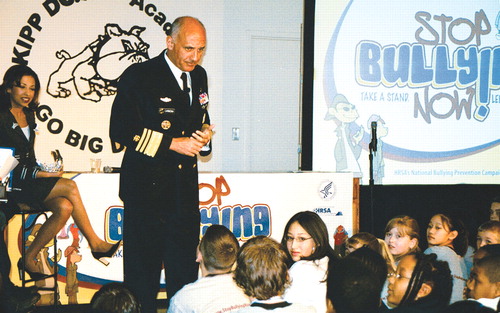Miss America Takes On Bullies and Their Victims
When last year’s Miss America was bullied in ninth grade, she endured racial and ethnic slurs, property vandalism, and death threats to her family. Erika Harold eventually changed to another school that was more diverse.
Harold, who is African American, white, and Cherokee Indian, said her experience led her to decide that she would speak out publicly against bullying if given the chance. After she won the Miss America pageant in 2003, she used her platform to address students about bullying.
 Last month, Harold joined U.S. Surgeon General Richard Carmona, M.D., in Washington, D.C., to announce the first public-education campaign designed to prevent bullying.
Last month, Harold joined U.S. Surgeon General Richard Carmona, M.D., in Washington, D.C., to announce the first public-education campaign designed to prevent bullying.
Students who are bullied are repeatedly called names, teased, put down, and sometimes threatened with violence or subjected to violent acts. They may withdraw, avoid school, develop low self-esteem, and become depressed, according to experts.
“Bullying can have long-term social and emotional implications for both the bully and the child being bullied. It is important for our society to discuss the problems and potential ramifications of bullying and then look for ways to prevent it,” Carmona said when he announced the new campaign, “Take a Stand. Lend a Hand. Stop Bullying Now!,” at Key Academy, a model elementary school in Washington, D.C.
The campaign was developed by the federal Health Resources and Services Administration (HRSA) in cooperation with 70 health, safety, education, and faith-based groups.
HRSA Administrator Betty James Duke, Ph.D., said that bullying varies by gender, with boys frequently engaging in punching, hitting, pushing, and shoving, while girls frequently engage in gossiping about other girls, excluding them socially, teasing, and spreading rumors about them.
There are exceptions, however. Girls and boys living in large towns and urban areas are more likely to bully using physical violence than students who bully in small towns or rural areas, according to Richard Sarles, M.D., president of the American Academy of Child and Adolescent Psychiatry. Sarles gives talks about bullying to medical students and consults to grade schools in the Baltimore area.
“The challenge for school administrations is to counteract the perception among students that bullies are cool. Psychiatrists who consult to schools can help them implement policies with clear-cut consequences for bullying and develop prevention programs that teach that bullying isn’t cool and empathy for the student being bullied.”
Surveys of grade-school children show that half of the children between the ages of 8 and 11 and two-thirds of those between the ages of 12 and 15 report that bullying is a major problem at their schools, Duke said.
Bullying has been linked to carrying weapons, behavioral problems, poor academic performance, substance abuse problems, and encounters with the criminal justice system, Duke said.
The Web site www.stopbullyingnow.hrsa.gov provides information on bullying, public-service announcements, animated educational segments, and a resource kit for schools and communities. ▪



